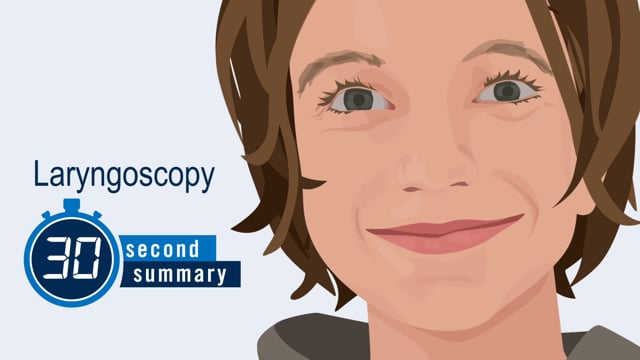Laryngoscopy
What Is Laryngoscopy?
Laryngoscopy is when a doctor uses a special camera to look down the throat to see the voice box (larynx) and vocal cords.
Ear, nose, and throat specialists (also called ENT doctors or otolaryngologists) do laryngoscopies. They can do:
- an indirect laryngoscopy: The doctor uses a small mirror and a light to examine the larynx and vocal cords.
- a direct flexible laryngoscopy or direct rigid laryngoscopy: The doctor looks into the throat directly without using mirrors.

30-Second Summary: Laryngoscopy
Learn the basics in 30 seconds.
Why Is Laryngoscopy Done?
Doctors do a laryngoscopy (lair-en-GOS-kuh-pee) to:
- look into what is causing a long-lasting cough, throat pain, ear pain, hoarseness or other voice problems, swallowing problems, or constant bad breath
- check for inflammation (swelling and irritation)
- look for a possible narrowing or blockage of the throat
- remove foreign objects, such as small toys swallowed by mistake
- get a sample of a mass or tissue in the throat or on the vocal cords
How Should We Prepare for Laryngoscopy?
Talk to your doctor about the kind of test, how it will be done, and any risks. Ask if your child should stop taking any medicines or stop eating and drinking before the test.
What Happens During Laryngoscopy?
Indirect laryngoscopy and flexible laryngoscopies often are done in the doctor's office. They usually take only 5 to 10 minutes.
Indirect laryngoscopy: Your child will sit up straight in a high-backed chair with a headrest and open their mouth wide. The doctor will spray the throat with numbing medicine, then cover the tongue with gauze and hold it down.
The doctor will hold up a mirror to the back of the throat and, with a light attached to headgear, will tilt the mirror to view various areas of the throat. Your child may be asked to make high-pitched or low-pitched sounds so that the doctor can see the larynx and watch the vocal cords move.
Flexible laryngoscopy: The doctor uses a flexible laryngoscope (a thin, flexible instrument that lights and magnifies images) for a better view of the larynx and vocal cords.
Often, doctors can do this in the office after giving a child numbing medicine. But sometimes it needs to be done in an operating room. If so, your child will get general anesthesia to sleep through the test and not feel any discomfort.
The doctor inserts the flexible scope through the nose or mouth, then looks down the throat through the scope's eyepiece. Sometimes the images display on a monitor so that others also see what the doctor sees.
Rigid laryngoscopy: This is done in an operating room. This test lets the doctor see farther down the throat. Rigid laryngoscopy is done with general anesthesia, so that a child is asleep and not feeling the procedure. If needed, the doctor will remove foreign objects from the throat, collect tissue samples (do a biopsy), do laser treatment, or remove growths from the vocal cords.
What Happens After Laryngoscopy?
If your child got local anesthetic or topical numbing spray, it will wear off in about 30 minutes. Your child should not eat or drink anything until the spray has worn off and the throat is no longer numb.
After a laryngoscopy with general anesthesia, your child will be watched until fully awake and able to swallow. This usually takes about 2 hours. In some cases, an overnight hospital stay may be needed. Your child may have some nausea, general muscle aches, and feel tired for a day or two.
Gargling with warm saltwater and sucking on ice pops or throat lozenges can help with soreness. Your child may sound hoarse or have noisy breathing for a few days after the procedure. This is normal. If the hoarseness lasts or your child has trouble breathing, call your doctor.
When Will We Get the Results of Laryngoscopy?
The doctor will explain the findings after the procedure. If a biopsy was taken, a lab will check the tissue and send the results to your doctor. This usually takes about 3 to 5 days. Your doctor will discuss the results and treatment options with you.


